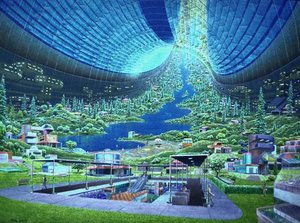Difference between revisions of "Space habitats"
| Line 3: | Line 3: | ||
[[Image:Stanford torus.jpg|300px|right]] | [[Image:Stanford torus.jpg|300px|right]] | ||
| − | There are many | + | There are many places to site a habitat in space, especially within the orbit of Jupiter. |
The easiest to get to from Earth is '''low earth orbit''', although due to the Earth's strong gravitational pull it requires enormous amounts of energy to bring material up from the surface and one could not be classed as self-sufficient here, however the views are pretty good. | The easiest to get to from Earth is '''low earth orbit''', although due to the Earth's strong gravitational pull it requires enormous amounts of energy to bring material up from the surface and one could not be classed as self-sufficient here, however the views are pretty good. | ||
| − | In a | + | In a [http://en.wikipedia.org/wiki/Geosynchronous_orbit '''geosynchronous orbit'''] the habitat would hover the same spot on Earth which would mean that one would have the same day / night cycle as on the surface which is an important consideration with human physiology. |
| + | In '''lunar orbit''' the moon is within easy reach but the habitat will be subject to the moons two-week long day / night cycles which might not be to everyone's taste, although of course the normal light rythms can be replicated internally with lighting. | ||
| + | The '''surface of the moon''' provides a continent-sized area to inhabit and somewhere to 'get outside'. However it is not clear that the one-sixth of Earth's gravity here is enough to stop degredation of the human over extended periods, but this could be overcome by having large circular habitats that rotate simulating a 1G environment. | ||
==Places== | ==Places== | ||
Revision as of 00:35, 21 September 2006
|

